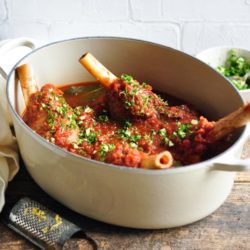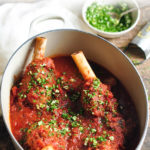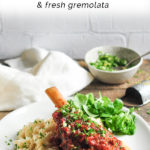Slow Cooked Lamb Shanks with Red Wine Sauce

- Prep Time: 30 mins
- Cook Time: 3 hours
- Total Time: 3 hours 30 minutes
- Yield: Serves 4-6
- Category: Dinner
- Method: Stove Top
- Cuisine: Australian
Slow Cooked Lamb Shanks with Red Wine Sauce, served with a fresh gremolata. The meat is deliciously tender and the rich, full-flavoured sauce is perfect for serving with mashed potatoes, polenta or pasta.
Ingredients
For the Braised Lamb Shanks
- 2–3 tablespoons vegetable oil
- 4 lamb shanks, about 2 kg or 4 lb
- 1 large brown onion
- 2 celery stalks
- 1 large carrot
- 3 garlic cloves
- 3 tablespoons tomato paste
- 1 cup (250 ml) red wine (please see Notes below)
- 3 x 400g (14 oz) canned diced tomatoes
- 2 cups (500 ml) chicken stock
- 2 teaspoons sugar
- 2 fresh bay leaves
- 1 large orange peel
- sea salt & freshly cracked pepper
For the Gremolata
- 1/2 cup flat-leaf parsley, finely chopped
- 1 garlic clove, finely chopped
- zest of 1 lemon
Instructions
- Preheat the oven to 350°F (180°C) (without fan).
- Heat the oil in a large oven-proof pot which will fit all of the ingredients comfortably.
- Sear the lamb shanks in batches until they are golden brown on all sides.
- While you are searing the lamb shanks, place the onion, celery and garlic into a food processor until finely chopped.
- Remove the lamb shanks to a plate.
- Turn down the heat. If the pan is really hot, remove it from the stove and let it cool a little.
- Add the onion mixture and cook for a few minutes until the vegetables have softenend.
- Stir in the tomato paste and cook for a few more minutes.
- Add the red wine and let the mixture bubble away for a few minutes to allow the alcohol to cook off.
- Add the canned tomatoes, stock, sugar, bay leaves, and orange peel.
- Bring the mixture to a boil and let it simmer gently for a few minutes.
- Return the lamb shanks to the pan, together with any meat juices on the plate. Make sure the shanks are well-submerged in the sauce.
- Place the lid on the pan, and place the pan into the oven for 2 hours to braise. Check the pan every 30 minutes or so to give it a stir.
- After 2 hours, place the pan back on the stove on low heat. Remove the lid.
- Skim off and discard as much fat as you can from the sauce.
- At this stage, the sauce should look quite thin.
- Let everything simmer gently, without the lid, for about 1 hour, or until the sauce has thickened nicely and the meat is very tender.
- Stir the sauce occasionally to make sure that it is not sticking to the bottom of the pan.
- Taste the sauce for seasoning, and add salt and pepper. If it tastes too tart or sour, you might need more sugar.
- Make the gremolata by mixing together the parsley, garlic and lemon zest.
- Serve the lamb shanks with risoni pasta, mashed potatoes, or polenta.
- Sprinkle generously with gremolata just before serving.
- If you plan to serve this dish with pasta (whether risoni pasta or another type of pasta), I would recommend warming the pasta through the sauce first. To do so, simply remove a few ladelfuls of sauce (or enough to serve with the pasta) into a medium saucepan and bring to the boil. Add the cooked and drained pasta, and stir everything together over high heat until the pasta is flavoured with the sauce. Alternatively, you can serve the pasta separately at the table, but this should be done as soon as the pasta is cooked and drained.
Kitchen Notes
There are several ways to serve this dish. If the lamb shanks are quite small, I would serve one lamb shank per person. Alternatively, you could pull the meat from the bones, and either serve the meat in large chunks or roughly shredded and mixed through the sauce. The latter is a good option for leftovers.
 WHICH TYPE OF WINE TO USE
WHICH TYPE OF WINE TO USE
I use Côte du Rhone red wine in my cooking (it’s the red wine which my French husband drinks on a daily basis), but any full-bodied red wine should work in this dish. Whilst you don’t need to use an expensive red wine when cooking, you should always use a wine which you would enjoy drinking – don’t cook with something you wouldn’t drink!
 OVEN TEMPERATURES
OVEN TEMPERATURES
All recipes on this website state temperatures for a regular oven (i.e. a conventional oven without fan). If you have a convection oven with a fan, please consult the manufacturer’s handbook on how to adjust the temperature and baking time accordingly.
 CONVERSIONS
CONVERSIONS
To convert from cups to grams, and vice-versa, please see this handy Conversion Chart for Basic Ingredients.
Nutrition
- Serving Size: 6
- Calories: 532
- Sugar: 13g
- Sodium: 665.3mg
- Fat: 17.7g
- Carbohydrates: 23.2g
- Fiber: 4.7g
- Protein: 67.7g
- Cholesterol: 199.4mg
View the recipe online: https://eatlittlebird.com/slow-cooked-lamb-shanks-with-red-wine-sauce/


